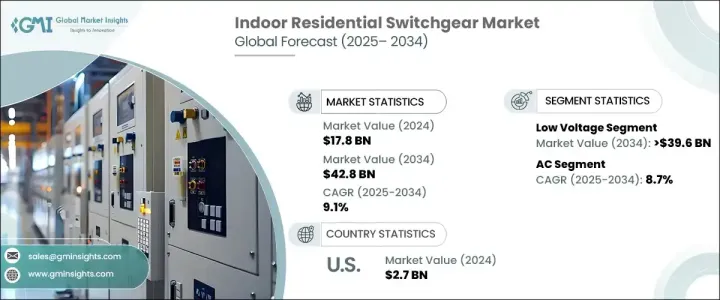PUBLISHER: Global Market Insights Inc. | PRODUCT CODE: 1716564

PUBLISHER: Global Market Insights Inc. | PRODUCT CODE: 1716564
Indoor Residential Switchgear Market Opportunity, Growth Drivers, Industry Trend Analysis, and Forecast 2025 - 2034
The Global Indoor Residential Switchgear Market generated USD 17.8 billion in 2024 and is projected to grow at a robust CAGR of 9.1% between 2025 and 2034. The market is witnessing substantial growth as global electricity consumption continues to rise, driven by rapid urbanization and the widespread integration of smart home technologies. As residential spaces become more advanced and technology-driven, the need for reliable, efficient, and intelligent power distribution solutions is becoming more critical than ever. Modern homeowners are increasingly seeking systems that not only distribute electricity safely but also improve overall energy management and contribute to home safety.

Growing awareness around energy efficiency, coupled with the rising demand for smart energy management systems, is propelling the adoption of advanced indoor residential switchgear. Moreover, increasing government initiatives supporting smart city development and the integration of renewable energy sources are amplifying the demand for smarter, safer, and energy-efficient residential infrastructure. With more focus on reducing energy waste and preventing electrical hazards, switchgear manufacturers are innovating to bring more compact, durable, and technology-enabled products to market, thereby expanding growth opportunities for the industry.
| Market Scope | |
|---|---|
| Start Year | 2024 |
| Forecast Year | 2025-2034 |
| Start Value | $17.8 Billion |
| Forecast Value | $42.8 Billion |
| CAGR | 9.1% |
Smart switchgear has become a critical innovation, enabling homeowners to monitor and control their electrical loads remotely, significantly enhancing both energy efficiency and home safety. The integration of the Internet of Things (IoT) and AI-based automation in these systems adds to their value proposition, giving users greater control over their residential energy consumption while minimizing risks of overload and faults. As consumer awareness about sustainable living and cost-saving energy solutions grows, more homeowners are investing in IoT-enabled switchgear systems to optimize power usage and reduce electricity bills. These intelligent devices not only streamline the flow of electricity but also provide real-time data and analytics to help homeowners make informed decisions about their energy consumption patterns.
In terms of voltage, the low-voltage segment of the indoor residential switchgear market is anticipated to reach USD 39.6 billion by 2034, fueled by rapid urban expansion, growing electricity needs in residential zones, the rising adoption of smart homes, and the integration of distributed renewable energy solutions. The increasing demand for enhanced safety features and compliance with stringent electrical safety standards also makes low-voltage switchgear indispensable in modern residential environments, helping manage and distribute power seamlessly and safely.
Additionally, the AC segment of the indoor residential switchgear market is projected to grow at a CAGR of 8.7% through 2034. With alternating current (AC) continuing to dominate global electricity transmission and distribution due to its efficiency in long-distance transmission, demand for reliable AC switchgear remains high in residential buildings, ensuring consistent and safe electricity distribution.
The U.S. indoor residential switchgear market alone generated USD 2.7 billion in 2024, driven by a surge in residential construction fueled by rapid urbanization, a growing population, and government initiatives focused on affordable housing development. As the construction of multi-family housing units, townhouses, and modern residential complexes accelerates, so does the demand for advanced indoor switchgear to meet evolving energy distribution and safety needs in these dynamic living spaces.
Table of Contents
Chapter 1 Methodology & Scope
- 1.1 Market definitions
- 1.2 Base estimates & calculations
- 1.3 Forecast calculation
- 1.4 Data sources
- 1.4.1 Primary
- 1.4.2 Secondary
- 1.4.2.1 Paid
- 1.4.2.2 Public
Chapter 2 Executive Summary
- 2.1 Industry synopsis, 2021 - 2034
Chapter 3 Industry Insights
- 3.1 Industry ecosystem analysis
- 3.2 Regulatory landscape
- 3.3 Industry impact forces
- 3.3.1 Growth drivers
- 3.3.2 Industry pitfalls & challenges
- 3.4 Growth potential analysis
- 3.5 Porter's analysis
- 3.5.1 Bargaining power of suppliers
- 3.5.2 Bargaining power of buyers
- 3.5.3 Threat of new entrants
- 3.5.4 Threat of substitutes
- 3.6 PESTEL analysis
Chapter 4 Competitive landscape, 2024
- 4.1 Strategic dashboard
- 4.2 Innovation & sustainability landscape
Chapter 5 Market Size and Forecast, By Voltage 2021 – 2034 (USD Million, ‘000 Units)
- 5.1 Key trends
- 5.2 Low
- 5.3 Medium
Chapter 6 Market Size and Forecast, By Current 2021 – 2034 (USD Million, ‘000 Units)
- 6.1 Key trends
- 6.2 AC
- 6.3 DC
Chapter 7 Market Size and Forecast, By Region, 2021 – 2034 (USD Million, ‘000 Units)
- 7.1 Key trends
- 7.2 North America
- 7.2.1 U.S.
- 7.2.2 Canada
- 7.2.3 Mexico
- 7.3 Europe
- 7.3.1 UK
- 7.3.2 Germany
- 7.3.3 France
- 7.3.4 Russia
- 7.3.5 Italy
- 7.3.6 Spain
- 7.4 Asia Pacific
- 7.4.1 China
- 7.4.2 Australia
- 7.4.3 India
- 7.4.4 Japan
- 7.4.5 South Korea
- 7.5 Middle East & Africa
- 7.5.1 Saudi Arabia
- 7.5.2 UAE
- 7.5.3 Turkey
- 7.5.4 South Africa
- 7.5.5 Egypt
- 7.6 Latin America
- 7.6.1 Brazil
- 7.6.2 Argentina
Chapter 8 Company Profiles
- 8.1 ABB
- 8.2 Bharat Heavy Electricals
- 8.3 CG Power and Industrial Solutions
- 8.4 CHINT Group
- 8.5 Eaton
- 8.6 Fuji Electric
- 8.7 General Electric
- 8.8 HD Hyundai Electric
- 8.9 Hitachi
- 8.10 Hyosung Heavy Industries
- 8.11 Lucy Group
- 8.12 Mitsubishi Electric
- 8.13 Ormazabal
- 8.14 Schneider Electric
- 8.15 Siemens
- 8.16 Skema
- 8.17 Toshiba




